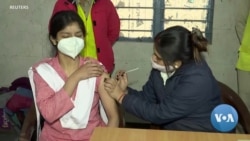As a third wave of the COVID-19 pandemic looms in India, driven by the omicron variant of coronavirus, authorities have begun giving shots to 15 to 18 year olds.
There was enthusiasm and a sense of relief among teenagers as they lined up outside medical centers and in schools where vaccines are being given – about 10 million got a shot since the start of the week.
“I feel more confident that I can now go out. I used to feel so scared when I went to school that I may get COVID and carry the infection to my parents and neighborhood,” said Ajay Verma, a high school student.
The inoculation drive for youngsters got underway amid an exponential jump in COVID-19 cases in mega cities like Delhi and Mumbai. After seeing a dramatic decline for months, India reported 58,000 cases Wednesday -- a sevenfold jump in just a week.
That has prompted authorities to impose fresh restrictions – officials in the capital, New Delhi, have announced a weekend curfew and closed gyms and movie theaters. In Mumbai, authorities said they will consider imposing a lockdown if daily cases cross the 20,000 mark. The city recorded more than 10,000 cases Tuesday.
Schools that reopened just months ago have again closed for in-person classes in many places.
That has created fresh anxiety among youngsters in a country where school closures lasted for nearly a year-and-a-half -- longer than in much of the world.
“Online school, it gets lonely. Schools in person is always much more fun so I am looking forward to it when it is safe,” says Sania Gupta, a high school student in Gurugram, a business hub adjoining New Delhi.
India’s inoculation drive began early last year, but even as several countries around the world have been vaccinating young children, health authorities had said they want to inoculate all adults before expanding the program. About two thirds of India’s adults have been fully vaccinated, while 90% have received one shot.
However, in the country with the largest estimated adolescent population in the world, calls were growing to also protect younger people, especially as India has an adequate vaccine supply.
“Sooner or later a wider population needs to be vaccinated, specially in India, where adults constitute only 63% of the total population, unlike some countries, such as Europe, where adults are around 80% of population,” said Chandrakant Lahariya, a public health expert. “So even if we vaccinate all adults, nearly one-third of the country is still unprotected.”
India has more than 120 million people between 15 and 19 years old, according to the country's 2011 census. And while adolescents have largely escaped the brunt of the pandemic, several countries have seen infections rising among children.
India, which has counted the second highest number of COVID-19 infections in the world, will also begin administering booster shots to health care workers and senior citizens with comorbidities starting Monday.
The expanded inoculation drive is raising hope that the country will not experience the devastation that was triggered by the delta variant last year when hundreds of thousands of daily infections overwhelmed hospitals and led to crippling shortages of oxygen. At that time much of the country was unvaccinated.
“Unlike the delta wave, where high proportion of infected individuals would require hospitalization, oxygen, and intensive care beds, in omicron the current evidence says infection is mostly mild and severe disease is mostly linked to pre-existing high-risk conditions or unvaccinated individuals,” said Lahariya.
“So, in that backdrop, cases might rise and that theoretically might be classified as a fresh wave, but the impact is not likely to be the same,” he pointed out.
That is what high school students getting shots are hoping as they yearn to resume a semblance of normalcy -- an estimated 200 million children have been affected due to school closures in India.
“I want schools to reopen so that I can get back into the habit of studying,” said high school student, Amit Sahu. “I just could not concentrate at home.” It’s a sentiment that many echo.










